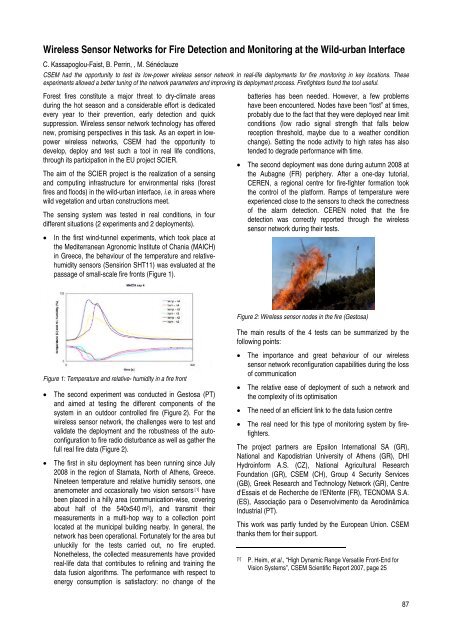CSEM Scientific and Technical Report 2008
CSEM Scientific and Technical Report 2008
CSEM Scientific and Technical Report 2008
Create successful ePaper yourself
Turn your PDF publications into a flip-book with our unique Google optimized e-Paper software.
Wireless Sensor Networks for Fire Detection <strong>and</strong> Monitoring at the Wild-urban Interface<br />
C. Kassapoglou-Faist, B. Perrin, , M. Sénéclauze<br />
<strong>CSEM</strong> had the opportunity to test its low-power wireless sensor network in real-life deployments for fire monitoring in key locations. These<br />
experiments allowed a better tuning of the network parameters <strong>and</strong> improving its deployment process. Firefighters found the tool useful.<br />
Forest fires constitute a major threat to dry-climate areas<br />
during the hot season <strong>and</strong> a considerable effort is dedicated<br />
every year to their prevention, early detection <strong>and</strong> quick<br />
suppression. Wireless sensor network technology has offered<br />
new, promising perspectives in this task. As an expert in lowpower<br />
wireless networks, <strong>CSEM</strong> had the opportunity to<br />
develop, deploy <strong>and</strong> test such a tool in real life conditions,<br />
through its participation in the EU project SCIER.<br />
The aim of the SCIER project is the realization of a sensing<br />
<strong>and</strong> computing infrastructure for environmental risks (forest<br />
fires <strong>and</strong> floods) in the wild-urban interface, i.e. in areas where<br />
wild vegetation <strong>and</strong> urban constructions meet.<br />
The sensing system was tested in real conditions, in four<br />
different situations (2 experiments <strong>and</strong> 2 deployments).<br />
• In the first wind-tunnel experiments, which took place at<br />
the Mediterranean Agronomic Institute of Chania (MAICH)<br />
in Greece, the behaviour of the temperature <strong>and</strong> relativehumidity<br />
sensors (Sensirion SHT11) was evaluated at the<br />
passage of small-scale fire fronts (Figure 1).<br />
Figure 1: Temperature <strong>and</strong> relative- humidity in a fire front<br />
• The second experiment was conducted in Gestosa (PT)<br />
<strong>and</strong> aimed at testing the different components of the<br />
system in an outdoor controlled fire (Figure 2). For the<br />
wireless sensor network, the challenges were to test <strong>and</strong><br />
validate the deployment <strong>and</strong> the robustness of the autoconfiguration<br />
to fire radio disturbance as well as gather the<br />
full real fire data (Figure 2).<br />
• The first in situ deployment has been running since July<br />
<strong>2008</strong> in the region of Stamata, North of Athens, Greece.<br />
Nineteen temperature <strong>and</strong> relative humidity sensors, one<br />
anemometer <strong>and</strong> occasionally two vision sensors [1] have<br />
been placed in a hilly area (communication-wise, covering<br />
about half of the 540x540 m 2 ), <strong>and</strong> transmit their<br />
measurements in a multi-hop way to a collection point<br />
located at the municipal building nearby. In general, the<br />
network has been operational. Fortunately for the area but<br />
unluckily for the tests carried out, no fire erupted.<br />
Nonetheless, the collected measurements have provided<br />
real-life data that contributes to refining <strong>and</strong> training the<br />
data fusion algorithms. The performance with respect to<br />
energy consumption is satisfactory: no change of the<br />
batteries has been needed. However, a few problems<br />
have been encountered. Nodes have been “lost” at times,<br />
probably due to the fact that they were deployed near limit<br />
conditions (low radio signal strength that falls below<br />
reception threshold, maybe due to a weather condition<br />
change). Setting the node activity to high rates has also<br />
tended to degrade performance with time.<br />
• The second deployment was done during autumn <strong>2008</strong> at<br />
the Aubagne (FR) periphery. After a one-day tutorial,<br />
CEREN, a regional centre for fire-fighter formation took<br />
the control of the platform. Ramps of temperature were<br />
experienced close to the sensors to check the correctness<br />
of the alarm detection. CEREN noted that the fire<br />
detection was correctly reported through the wireless<br />
sensor network during their tests.<br />
Figure 2: Wireless sensor nodes in the fire (Gestosa)<br />
The main results of the 4 tests can be summarized by the<br />
following points:<br />
• The importance <strong>and</strong> great behaviour of our wireless<br />
sensor network reconfiguration capabilities during the loss<br />
of communication<br />
• The relative ease of deployment of such a network <strong>and</strong><br />
the complexity of its optimisation<br />
• The need of an efficient link to the data fusion centre<br />
• The real need for this type of monitoring system by firefighters.<br />
The project partners are Epsilon International SA (GR),<br />
National <strong>and</strong> Kapodistrian University of Athens (GR), DHI<br />
Hydroinform A.S. (CZ), National Agricultural Research<br />
Foundation (GR), <strong>CSEM</strong> (CH), Group 4 Security Services<br />
(GB), Greek Research <strong>and</strong> Technology Network (GR), Centre<br />
d'Essais et de Recherche de l'ENtente (FR), TECNOMA S.A.<br />
(ES), Associação para o Desenvolvimento da Aerodinâmica<br />
Industrial (PT).<br />
This work was partly funded by the European Union. <strong>CSEM</strong><br />
thanks them for their support.<br />
[1] P. Heim, et al., “High Dynamic Range Versatile Front-End for<br />
Vision Systems”, <strong>CSEM</strong> <strong>Scientific</strong> <strong>Report</strong> 2007, page 25<br />
87








